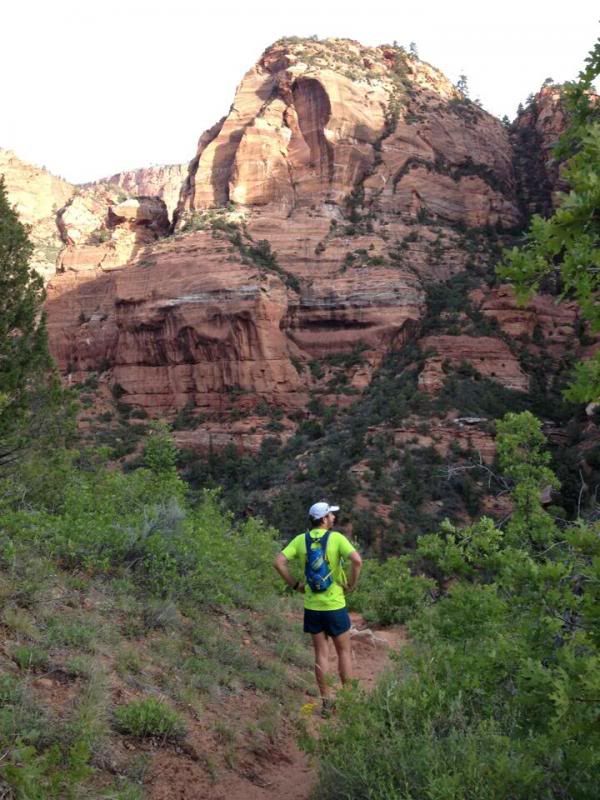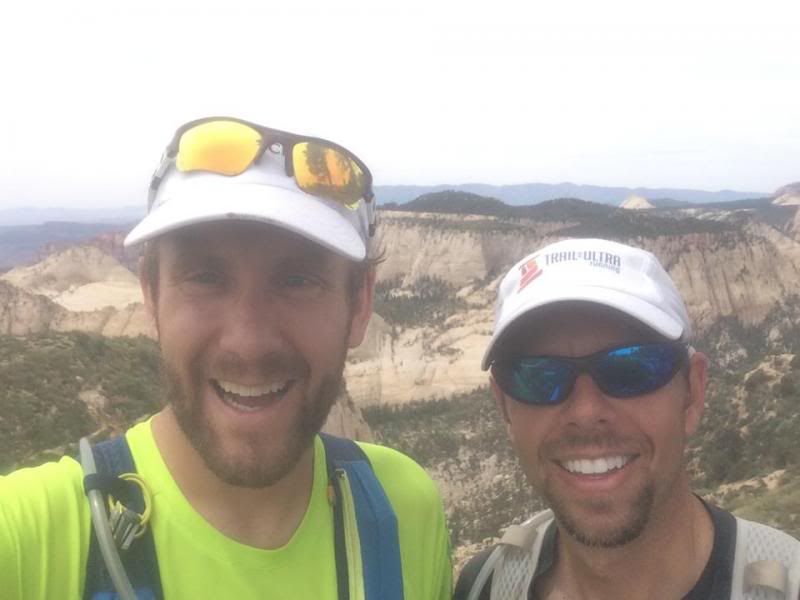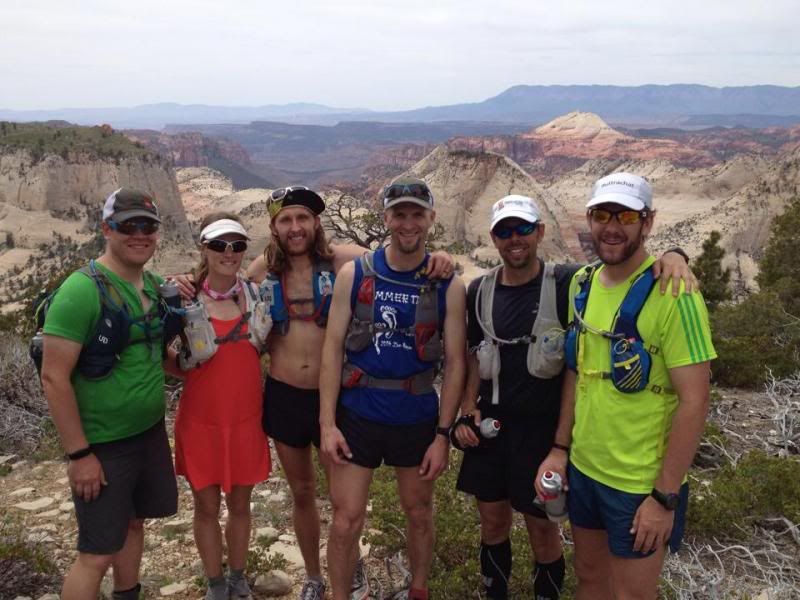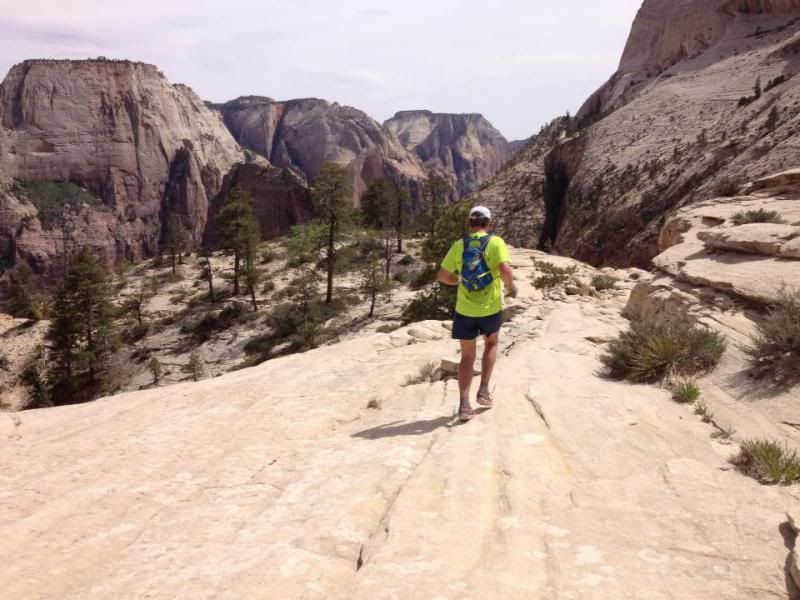By MVH
Alarm at 4 AM. More tired than I wish, but I swing my legs
out of bed and begin my early morning express routine. Contacts in, pull on
shorts, shirt, long wool socks and sturdy black mountaineering pants. I sit at
the top of the stairs for a minute and rub the cat’s belly, then to the kitchen
where I mix and gulp a powdered breakfast drink. I reach into the refrigerator
and grabbed water and food that had been chilling overnight. I would need
substantial food – real food, not the syrupy gel I had been used to taking on
my running outings. It is late May in the Wasatch mountains of Northern
Utah. While the season shifts to Summer and the lower trails blossom in
foliage, up high the peaks and basins show off bright white consolidated snow.
I was going up high.
I decided to traverse a particular rugged ridge above the
Cottonwood canyons. I am familiar with the area and have done the traverse
several times. As per my habit, I did not make up my mind until last minute
about which approach to take. Should I go up Broads Fork to the notch between
Dromedary and Sunrise Peaks, or should I hike up Tanner’s Gulch on the other
side, in a different canyon, to reach the same notch? I had no partners with
me, and therefore no shuttle car waiting at the end of whatever approached I
decided to take. I drove through Salt Lake City as dawn appeared in the East in the form of a faint outline of mountains. At the exit to highway 215
Eastbound – and the Big Cottonwood/Broads approach, I vacillated, and almost
took the turn. Tanners it would be. A few more miles of freeway, then I exited
to 90th South, which would take me into Little Cottonwood Canyon.
Several miles up the canyon I pulled over at the curve in
the road a hundred yards above the Tanners Flat Campground. There is an
unmarked trail there, which leads into one of the longest, steepest, and most
deadly slide paths in all of the Wasatch: Tanners Gulch. There is only one
season I ever go in there, Spring. I will stay out of the gulch in Winter, for
the obvious reason. In the Summer and Autumn months the snow is gone and loose,
steep, rocky terrain is exposed. I still felt tired. Not just body tired, but
head tired. It was 5:15 AM and I decided to hop into the back seat for a nap.
A short time later I got up, changed into my boots, attached my mountaineering
axe to my pack, and disappeared into the green alpine foliage.
I have been in Tanner’s gulch several times, and it never
looks identical to the previous time. Sometimes snow is so low it reaches down
to where the access trail connects to the creek. Usually the snow is receded
farther up the narrow, granite-walled slide path. Always there is a creek of
ice cold pure meltwater rushing down to join Cottonwood Creek in the canyon. I
stepped onto the creek bed and began my ascent, hopping over myriad rounded
stones of various size. I had to hop across the stream a few times to avoid
getting my feet wet. The bed reminded me of a beach – without the sea odor and
salt - with fine sand between scattered rocks. Up canyon I could see the
toe of the snow pack. It looked quite literally like the dirty white head of a
frozen flash flood. Above it was 4,000 feet of uninterrupted snow laying over
millennia of rock fall talus and eroded granite slabs.
Lower Tanner's Gulch (Photo: BigNick, Summitpost)
At the toe a cold stream
of water rushed fiercely out of a dark, self-made tunnel. I stepped onto the
snow and continued up at a quicker pace without any obstacles to slow me. The
lower gulch, with its steep granite walls, has striking features – figuratively
and literally. I was cautious of rock fall as I ascended higher, removing my
earphones to listen for any sounds of rock on rock. The carcass of a large pine
tree lay on top of the consolidated snow. I admired the dry, rich tree flesh,
thinking it would be good to burn in a campfire. Other large pieces of its body
lay nearby. Grey granite rocks the size of drink coolers and smaller dotted the
path upward, like breadcrumbs leading me to the heights. I arrived at the first
split in the gulch. I had to choose: Left over a waterfall, or right over
trashy, lumpy and deeply cupped snow. I went left. Last year the waterfall was
fully exposed and required a careful climb to the side to bypass. This time
only its top could be seen draining into a deep, dark hole. It was very
pleasant to look at, and the climb around it to the snow above was pleasantly
simple and safe. It was at that place I sat and attached my crampons for the
remainder of the climb. Up higher I transgress the line between the grey
majestic granite slabs of the lower gulch and the broken red quartzite
environment of the upper ridge massif. Fortunately I was able to ascent mostly
on snow, having to hike short sections on dry rock. At the top third of Tanners
Gulch I had the option of staying left in the main branch, or entering a narrow
choke that leads more directly up the South face of my first intended peak. If
I had an inexperienced partner with me I would have certainly chosen the left.
Being alone, I favored the direct and therefore faster route to the summit,
knowing of the small waterfalls I would have to work around or over, and the
steepness of the slope. I entered the choke through a natural quartzite gate,
then moved quickly up slope on all fours. I fatigued quickly after several
steps, then continued up. I repeated this pattern all the way up. Above me I
saw the waterfall that I had been able to climb up and over in past years was
fully exposed and impassable. I looked to the right and left to find a
work-around. I decided left. It was good and within a few minutes I was above
the waterfall. A few words about the angle of the slope in this branch: It is
steep and slick – steep enough that if a climber slipped and lost all grip on
the consolidated snow, he would slide out of control and collide with several
jagged quartzite humps lining and jutting into the drainage. After likely
breaking several bones and fracturing the skull, as well as receiving deep
lacerations, the limp body of the unconscious, dying or dead climber would
continue to be pulled by gravity downslope, bounce once more off the left hand
gate of the choke, then slip out and begin to tumble another several hundred
feet into the wide upper gulch. The body would probably not stop there, but
continue twisting downward until it got hung up in the trees growing on a hump
of granite, or brought to a halt by friction on a less-steep section of ground.

Upper Tanner's Gulch
I had my earphones out for this part of the climb, too,
because there was a risk of rock fall in this narrow chute (although, there was
not a tell-tale runnel in the length of the chute, indicating that rock fall
was rare). As I approached a low barrier of rock that had planned to climb
over, I suddenly felt myself falling as the snow beneath me collapsed.
Instinctively I spread my arms and caught myself with my forearms resting on
the surface. My legs dangled in dark space below me. Only my arms and head
remained above the surface. I looked down and saw no bottom. I heard the water
beneath me. Somehow in the collapse I had turned a full 180 degrees and was
facing downslope. I kicked my feet in all directions but the only direction I
felt anything solid was behind me on the rock. I hung there several moments,
becoming aware of the absolute necessity for me to get out before I fell into
the hole under the snow. I shifted my weight forward slightly in an attempt to
heft myself up and out. The snow I clung to collapsed again and I scrambled to
gain a new hold. I swung my legs back and rested my feet on the rock. Then I
pushed off and got my chest above the hole. I still had my axe out so I swung
it forward and caught a hold, and awkwardly pulled the rest of myself out of
the hole, facing downslope. This scared me. I didn’t even want to look in the
hole I had just escaped. I caught my breath, said a prayer of gratitude, turned
and continued up.
The last few hundred feet up the South face of Dromedary are
at the steepest angle. I would climb a couple dozen feet up, stop to breath
hard, then repeat. Bright sunlight reflected off the orange-red quartzite above
me. When I reached the ridge top I followed it right and scrambled to the
summit. There was less snow up there than I had expected. Much of the rock was
exposed, where in past years it was a climb over thick snow. I sat on the
summit, hungry from the effort and excitement down below, and had a breakfast
of smoked ham, spicy antelope salami, and Swiss cheese.
The view from atop Dromedary Peak is magnificent. I could
see the entire Cottonwood Ridge running East from the peak. I could see
virtually all of the 11,000 foot Central Wasatch peaks, all white and spotted
with exposed rock. It reminded me of white chocolate chip mint ice cream.
Retracing my steps I descended the West ridge of Dromedary, careful not to slip
on the steep angle back down the face, from where I had just climbed up. There
is a short section where I turned toward the snow to kick steps and downclimb.
Just above where the ridge meets the notch between the peaks there is usually a
wide, more gentle snow-covered ramp that runs down to the upper Broads Fork
bowl. This time the snow was only half-covering the slabs, so I made careful
steps down and around the corner to hike back up to the notch. Form the notch I
climb steeply up over mixed rock and snow surfaces. Several times I climbed on
the apex of snow atop the ridge, a true knife edge. The snow was good and firm,
and held my boots in place. I kept my crampons on, even while climbing over dry
rock. It was too time-consuming to remove them because I would need them again
to descend to the saddle leading to Twin Peaks. I reached the summit of Sunrise
Peak in about 3.5 hours. I sat down and enjoyed another short meal, this time
with the view to the Southwest before me. I could see into Coalpit Gulch,
Hogum, and had proud views of the Pfeifferhorn and Lone Peak. On a snowy
December morning in 1936, a passenger plane from California carrying a half ton
of US mail and seven individuals crashed in upper Hogum Gulch. Recovery of the
bodies took up to six months and among the debris was found a love letter from
a young man to the stewardess aboard the doomed airplane. Scraps of the
aircraft remain high in the gulch. From across the canyon I scanned the area,
speculating on where the crash site could be.

Sunrise Peak, 11,280 feet
I descended Sunrise, then ascended the smaller bump known as
Jeppsen’s Folly. There is a more direct way down from Jeppsen’s, the so-called
West buttress, but it is nearly vertical and usually snow-filled. I opted to
downclimb around to the left over more forgiving terrain. The traverse under
the West buttress is where I really needed the crampons. An accidental slide
there would be deadly, and would send my body tumbling to the depths below. At
the South end of the saddle I made an easy walk to its North end, then found
the familiar crack in the wall leading to the high bench a few hundred feet
below the summit of East Twin. The hike up was easy, and within minutes I had
reached the summit. Not stopping, traversed to the West Twin. Within 10 minutes
I stood on the last peak of the “Triple Traverse”. I had to decide where I wanted
to go from there. Do I call it good and descend through Broad’s Fork? Or, I
could have continued on the ridge down from the West Twin into unfamiliar
terrain into Deaf Smith Canyon. I seriously considered that option. There would
be no trail. I would have to hitch-hike back to my car in Little Cottonwood
Canyon for those two options. The third option was to retrace all of my steps
to that point, going back over all the peaks, including back up to Dromedary,
and drop back down Tanner’s. I would get a “Double Triple Traverse.” I decided
I would do that. I wanted to get back to my car without having to beg for a
ride.

L-R: Dromedary, Sunrise, Jeppsen's (Photo: Travis Atwood, May 2009)
The descent back to the saddle from the Twins was quick, and I
downclimbed the crack in the wall with pleasure. As I walked up to the base of
the West buttress I saw that it was nearly clear of snow. I decided to climb
the 5.5 route up instead of traversing around as I had done on the way over. I
had climbed this buttress several times, but my favorite alcove still held
snow, so I climbed just to the left of it. I got a little out of my comfort
zone, making a few committing moves, clinging to rock as my body hung over a
significant vertical drop. In the case of a fall, if I somehow escaped bashing
against jagged quartzite, I would bounce off a 45 degree snow slope and
continue into that rocky abyss below. When I was back on comfortable rock with
large hold and ledges, I sighed relief. I am not a rock climber.
Broad's Fork Twin Peaks (Photo: Ammon Hatch, May 2009)
Climbing back up Jeppsen’s and Sunrise went quickly without
crampons. I pulled myself up and over large rocks, staying close to the ridge
top. To my left was a sheer drop of hundreds of feet into upper Broad’s Fork.
Below me and a half-mile away as the crow flies, I could see two figures hiking
over snow up into the basin. I wondered if they could see me up on the peaks.
Upper Broad’s Fork was still completely covered in deep snow, and the Twins’
East flank was still mostly white even after the glide avalanches had released.
Further in the distance I could see the beaver pond and the adjacent meadow
were completely dry and green. Snow was melting quickly in the late May heat
wave. As I climbed up and over Sunrise Peak, only two things ahead worried me.
I could get to the summit of Dromedary with no problem, but how would the snow
in upper Tanner’s Gulch be? I was concerned about wet slide avalanches as the
temperature rose. After the incident of falling in the hole on the first climb
up Dromedary, how likely would it be for me to fall into a deeper, more
dangerous hole in lower Tanner’s Gulch? The draining water runs stronger down
below, and the gulch narrows considerably. I must be very careful and alert. I
reached the summit of Dromedary for the second time. One last meal on top, then
I descended to the notch atop Tanner’s. I peered over the edge down into
the steep, narrow upper gulch. The snow had been softening in the morning heat.
I judged it to be good enough to descend, and carefully lowered myself down at
the edge of the notch, in a gap between rock and snow. Stepping out onto the
snow, I felt it was just right for a quick plunge-step descent. Then I
determined it would be good for glissading. I sat down on the snow with my feet
straight in front of me and let gravity pull me down. I slid a thousand feet
down in a few minutes, enjoying the free ride out of the narrow top portion of
the gulch, then through the wide snowfield of the middle portion. I stopped and
stood up not far above the waterfall, and walked down to it. Where the cold
clean water poured out from underneath snow, there was a small platform before
it fell over and disappeared again into a black hole under snow. I stood there
and filled a bottle with cold, clean water. I drank it all, them refilled. I
made a short jump down from the waterfall onto snow, careful not to land directly
above the creek. The grey granite walls of the gulch rose up high to my right,
and less dramatically to my left. I listened for rock fall, and moved quickly
down canyon. I passed the battered tree trunk. I tried glissading again but the
surface of the snow was violently bumpy. I followed the long tongue of snow
downward. Ahead and below I could see the green, dry woods of the canyon lit up
in sunshine. I hiked up the bank and found the hiker’s trail, and within a few
minutes arrived back to my vehicle parked at a curve in Little Cottonwood
Canyon. My total time from start to finish was 7 hours and 57 minutes. A few
years ago my time to complete just one traverse of the same peaks was over 8
hours. Several years ago my first traverse over the same peaks was over 12
hours. I said a prayer, grateful for my safe return, and drove home.


















